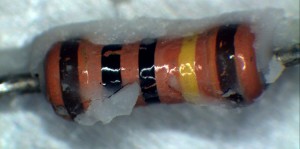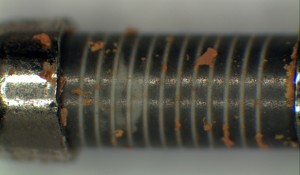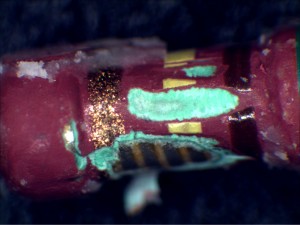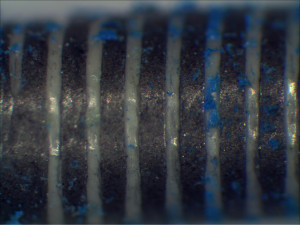Resistor Contamination on Axial-Lead Resistors
Gideon Analytical Laboratories received three axial-lead resistors for failure analysis (pictured in the first picture directly below). A resistor is a passive two-terminal electrical component that implements electrical resistance as a circuit element. Their purpose is for creating a precise quantity of resistance for insertion into a circuit; they are typically constructed of metal wire or carbon and engineered to maintain a stable resistance value over a wide range of environmental conditions. Gideon Analytical Laboratories was tasked to identify the cause of failure in these resistors.
Gideon Analytical Laboratories conducted failure analysis. All three resistors tested open. There was no damage to the epoxy coating on the resistor. This coating was removed to expose the metal on an alumina shaft. The resistors were open due to the metal dissipating more in one area than others.
The resistors were analyzed in the SEM-EDS for foreign material. The second picture below is an SEM micrograph of one of the failures. The metal is depleted to the point where the distinction between the trough and the metal height are gone. The bottom picture shows a failed resistor with a large void at the right, not connecting to the lead.
Gideon Analytical Laboratories discovered through cross-sectioning and SEM-EDS analysis that the metal on all three resistors was dissipated to the point where opens occurred. This usually occurs when the resistor is used in excess of the power rating, however, this may be caused in conjunction with chlorinated hydrocarbons which soften the epoxy coating and allowed penetration to the resistor metallization. The silicone encapsulation was identified using FTIR.
Gideon Analytical Laboratories can provide invaluable information through failure analysis to companies in the electrical component industry. By using failure analysis performed by Gideon Analytical Laboratories, electronics companies can diagnose and fix causes of problems, saving enormous amounts of time, money, and headaches in the future.

Resistor sym1128-1 Coating

The sym1128-2 stripped resistor with missing metal

Epoxy coating compromised with chemicals

New resistor showing metallization